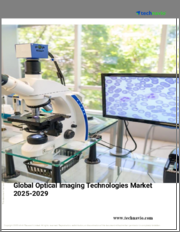
|
시장보고서
상품코드
1532952
광학 이미징 시장 : 예측(2024-2029년)Optical Imaging Market - Forecasts from 2024 to 2029 |
||||||
광학 이미징 시장은 2024년 29억 3,900만 달러에서 2029년 46억 6,700만 달러로 연평균 9.69% 성장할 것으로 예상됩니다.
광학 이미징은 빛을 이용해 신체 조직이나 세포의 이미지를 획득하고, 그 전에 조직 구성이나 생체 분자 과정으로부터 정보를 추론하는 기술입니다. 자외선부터 근적외선까지의 광자를 사용하여 이미지를 생성합니다. 광간섭단층촬영(OCT), 내시경, 광음향 이미징 등 다양한 종류가 있습니다.
이러한 이미징은 주로 연구자, 생명공학자, 약사들이 암과 림프종 검출, 부인과 악성 종양 연구, 생체 내 이미징, DNA 연구, 신생아 및 성인 뇌 이미징과 같은 작은 동물 모델 연구 및 임상 응용에 주로 사용됩니다. 광학 이미징은 비 이온화 방사선의 도움으로 환자의 유해한 방사선 노출을 줄입니다. 생물 의학 연구 및 의료에 널리 사용됩니다.
광학 이미징 시장 촉진요인:
- 바이오 의료 및 바이오의약품 연구의 성장 촉진은 시장 확대를 촉진할 것으로 예상됩니다.
광학 이미징은 연구자, 약사, 바이오 기술자에게 복잡한 인간, 동물, 식물 모델 연구에 유용한 정보를 제공하는 필수적인 기술입니다. 바이오메디컬, 바이오의약품, 의료, 특히 안과 의료 분야의 연구가 광학 이미징 시장의 성장에 기여하고 있습니다. 미국 산업안전보건연구소(NIOSH)의 보고서에 따르면, 미국에서는 매일 약 2000명의 근로자가 업무와 관련된 눈 부상으로 고통받고 있으며, 이에 대한 치료가 필요합니다.
- 만성질환의 증가로 시장 확대 가속화
정확한 녹내장 스크리닝을 위해서는 실명으로의 진행을 막는 조기 진단과 치료를 위한 새로운 광학 이미징 기술을 사용해야 하며, Vivo 이미징, 특히 전신 Vivo 이미징은 인간 질환의 동물 모델 연구를 가능하게 하여 동물 실험의 비율을 줄이고 연구 연구에 필수적인 정보를 제공합니다. Vivo 이미징의 다른 용도로는 미생물학에서 사용되는 생물 발광과 임상 연구에서 일반적으로 사용되는 Vivo 이미징의 형광 방법이 있습니다.
- 새로운 기술 발전으로 시장 확대 가속화
예를 들어, CT(컴퓨터단층촬영), MRI(자기공명영상), PET-CT(위치방사선단층촬영-컴퓨터단층촬영) 등의 새로운 기술 개발은 의료 영상 진단 기술에 널리 적용되고 있습니다. 또한, 광학 이미징을 향상시키는 새로운 소프트웨어의 출시도 이루어지고 있습니다. 예를 들어, Abbott Laboratories는 2023년 10월 인공지능과 광학 일관성 단층촬영(OCT)을 통합한 혈관 이미징 소프트웨어 'Ultreon 1.0'을 발표했습니다.
연구자들은 3D 광학 이미징과 3D 디스플레이를 연구하고 있으며, 의료, 로봇 공학, 보안, 감지, 시각화, 디스플레이 능력 등에 적용되고 있습니다. 예를 들어, 3D 의료 이미징은 클리닉과 수술실에서 질병의 예방, 진단 및 치료를 개선하는 새로운 기술입니다. 광학 이미징 생물 발광, 화학 발광, 잔광 이미징, 매크로 메소스코픽 영역을 가진 NIR-II 프로브를 이용한 이미징 프로브는 심부 조직 이미징 연구의 새로운 발전입니다.
광학 이미징 시장 억제요인:
- 임상 전문 지식의 부족으로 시장 성장 억제
광학 이미징은 질병 발견과 암 치료에 큰 잠재력을 제공합니다. 그러나 최적의 이미징 보급률이 낮고, 흡수 및 산란 문제, 임상 장비 및 전문 지식의 부족으로 인해 광학 이미징 시장의 성장을 저해할 가능성이 높습니다.
광학 이미징 시장의 지리적 전망
- 예측 기간 동안 북미가 광학 이미징 시장에서 큰 점유율을 차지할 것으로 예상됩니다.
북미는 눈, 뇌, 암 및 기타 질병에 대한 연구와 기술 발전의 증가, 더 나은 진단을 위해 광학 이미징이 주로 적용되는 질병의 급증으로 인해 상당한 시장 점유율을 차지할 것으로 예상됩니다. Heidelberg Engineering Inc., Carl Zeiss Meditec, Bruker Corporation, Leica Microsystems와 같은 시장 진입자들의 입지가 확립된 것도 이 지역의 시장 성장에 긍정적인 영향을 미치고 있습니다.
미국 질병통제예방센터(CDC)에 따르면, 미국에서는 40세 이상 약 1,200만 명이 시력 장애를 앓고 있으며, 그 중 800만 명에 가까운 사람들이 시력 장애를 앓고 있지만, 치료받지 못하고 있습니다. 주요 안질환으로는 녹내장, 당뇨망막병증, 백내장, 굴절 이상 등이 있습니다.
뇌 질환은 주로 알츠하이머병, 뇌종양, 치매, 파킨슨병으로 미국에서 많은 사람들이 사망하고 있습니다. 또한 MRI 스캔은 뇌의 이미지를 감지하고 결과를 추측하는 데 사용되는 기술입니다. 유방암과 뇌종양은 미국의 주요 암 관련 사망 원인 중 하나입니다.
컴퓨터 단층촬영(PET-CT) 스캔이나 방사성 단층촬영과 같은 영상 기술은 암의 병기와 전이 정도를 보다 정확하게 판단하기 위해 사용되고 있습니다. 또한, 인공지능과 같은 새로운 기술도 의료용 영상 애플리케이션에 도입되고 있어 광학 이미징에 새로운 성장 전망을 가져오고 있습니다.
또한, 광학 이미징은 의료 분야에서의 높은 응용 가능성 외에도 NASA와 같은 주요 우주 기관이 이러한 기술에 투자하고 있는 우주 임무에서도 활로를 찾고 있습니다.
광학 이미징 시장의 주요 발전
- 2024년 4월: Spectral Instruments Imaging은 Vivo 광학 이미징 소프트웨어의 최신 버전 "Aura 4.5"를 발표했습니다. Aura 4.5는 정확한 자동화와 독자적인 "Kinetics Mode" 알고리즘을 기반으로 실시간 동적 생체 발광 신호를 포착하고 분석합니다.
- 2024년 2월: Bruker Corporation은 전임상 생체 내 광학 이미징 시스템 개발 전문기업인 Spectral Instruments Imaging LLC를 인수한다고 발표했습니다. 이번 인수를 통해 브루커는 질병 연구를 위한 'BioSpin Preclinical Imaging' 부문을 확장할 수 있게 됐습니다.
- 2023년 10월: Abbott Laboratories는 인도에서 새로운 혈관 이미징 소프트웨어 "Ultreon 1.0"의 출시를 발표했습니다. 인공지능과 광간섭단층촬영(OCT)을 결합한 세계 최초의 혈관 내 이미징 소프트웨어로, 의사는 관상동맥의 막힘과 혈류를 포괄적으로 파악할 수 있습니다.
- 2023년 9월: Revvity Inc.는 전임상 연구 방법의 혁신을 촉진하기 위한 이미징 시스템 IVIS(R) Spectrum 2, IVIS SpectrumCT 2, Quantum GX3 microCT를 출시했습니다. 이 표준 제품들은 생체 내 및 생체 외 분야 모두에서 감도 수준을 향상시키는 것을 목표로 하고 있습니다. 광학 이미징.
- 2023년 9월: Yole Group의 파트너인 PISEO는 광학 이미징 테스트 서비스를 시작한다고 발표했습니다. 이 서비스는 고부가가치 의료 분야에서 전체 광학 이미징 체인을 특성화하기 위해 신뢰할 수 있는 첨단 장비를 사용합니다.
목차
제1장 소개
- 시장 개요
- 시장 정의
- 조사 범위
- 시장 세분화
- 통화
- 가정
- 기준 연도와 예측 연도 타임라인
- 이해관계자에 대한 주요 이점
제2장 조사 방법
- 조사 디자인
- 조사 과정
제3장 주요 요약
- 주요 조사 결과
제4장 시장 역학
- 시장 성장 촉진요인
- 시장 성장 억제요인
- Porter's Five Forces 분석
- 업계 밸류체인 분석
- 애널리스트의 견해
제5장 광학 이미징 시장 : 기술별
- 소개
- 내시경 검사
- 광간섭단층촬영(OCT)
- 광음향 영상
- 라만 분광법
- 초해상 현미경(SRM)
- 확산광토모그래피(DOT)
제6장 광학 이미징 시장 : 용도별
- 소개
- 안과
- 종양
- 치과
- 피부과
- 신경
- 기타
제7장 광학 이미징 시장 : 지역별
- 소개
- 북미
- 미국
- 캐나다
- 멕시코
- 남미
- 브라질
- 아르헨티나
- 기타
- 유럽
- 독일
- 프랑스
- 영국
- 이탈리아
- 스페인
- 기타
- 중동 및 아프리카
- 사우디아라비아
- 이스라엘
- 아랍에미리트
- 기타
- 아시아태평양
- 중국
- 일본
- 한국
- 인도
- 인도네시아
- 대만
- 기타
제8장 경쟁 환경과 분석
- 주요 기업과 전략 분석
- 시장 점유율 분석
- 합병, 인수, 합의 및 협업
- 경쟁 대시보드
제9장 기업 개요
- ZEISS Group
- Leica Microsystems
- Topcon Corporation
- Heidelberg Engineering GmbH
- Santec Corporation
- Luneau Technology USA
- Headwall Photonics
- Koninklijke Philips N.V.
- NIDEK CO., LTD.
The optical imaging market is poised to reach US$4.667 billion in 2029 from estimated value of US$2.939 billion in 2024 at 9.69% (CAGR).
Optical imaging uses light to obtain images of body tissue or cells, before which the information is deduced from tissue composition and biomolecular processes. It generates images using photons of light from ultraviolet to near-infrared. Such imaging comprises various types, such as optical coherence tomography (OCT), endoscopy, and photoacoustic imaging, among others.
Optical Imaging is primarily used by researchers, biotechnicians, and pharmacists to study small animal models and clinical applications, such as the detection of cancer and lymphoma, the study of gynaecologic malignancies, in vivo imaging, research on DNA, neonatal and adult brain imaging, and other applications. Optimal Imaging reduces a patient's exposure to harmful radiation with the help of non-ionizing radiation. It is widely used in biomedical research and medical care.
Optical Imaging Market Drivers:
- Bolstering growth in biomedical and biopharmaceutical research is expected to propel the market expansion.
Optical imaging is an essential technique that provides useful information to researchers, pharmacists, and biotechnicians for studying complex human, animal, and plant models. Research in biomedical, biopharmaceutical, and medical care, especially in eye care, is contributing to the optical imaging market's growth. The National Institute for Occupational Safety and Health (NIOSH) reports that about 2000 US workers suffer from job-related eye injuries daily that require medical treatment.
- Growing chronic disease prevalence has accelerated the market expansion.
Accurate glaucoma screening requires using novel optical imaging techniques for early diagnosis and treatment that would stop the progression to blindness. Vivo imaging, particularly whole-body Vivo imaging, enables the study of animal models of human diseases, reducing the rate of experimentation on animals and providing essential information in research studies. Other applications of Vivo imaging can be seen in bioluminescence, which is used in microbiology, and fluorescence methods in vivo imaging, which are commonly used in clinical research.
- New technological developments are accelerating the market expansion.
New developments in optical imaging techniques, for instance, CT (Computed Tomography), MRI (Magnetic Resonance Imaging), and PET-CT (Position Emission Tomography - Computed Tomography), are widely applied in medical imaging techniques. Additionally, new software launches to bolster optical imaging are also taking place. For instance, Abbott Laboratories, in October 2023, launched its vascular imaging software "Ultreon 1.0", which integrates Artificial Intelligence and optical coherence tomography (OCT), which enables physicians to get a comprehensive view of coronary arteries.
Researchers have researched 3D optical imaging and 3D display, with applications in medicine, robotics, security, detection, visualization, and display abilities. For example, 3D medical imaging is a new technology that can improve disease prevention, diagnosis, and treatment in clinics and operating rooms. Optical imaging through imaging probes using bioluminescence, chemiluminescence, afterglow imaging, and NIR-II probes having macro-mesoscopic regimes are new advances in studying deep tissue imaging.
Optical Imaging Market Restraints:
- Lack of clinical expertise is expected to restrain the market growth.
Optical imaging provides a major scope for disease detection and cancer care. However, the low penetration of optimal imaging, absorption, and scattering issues, and the lack of clinical instrumentation and expertise will likely hamper the optical imaging market's growth.
Optical Imaging Market Geographical Outlook
- During the forecast period, North America is expected to hold a significant share of the optical imaging market.
North America is projected to account for a considerable market share due to increased research and technological advancements, and the surge in eye, brain, cancer, and other diseases, where optical imaging is majorly applied for better diagnosis. Well-established presence of market players, namely Heidelberg Engineering Inc., Carl Zeiss Meditec, Bruker Corporation, Leica Microsystems, and others, has also positively impacted the regional market growth.
Regional economies, namely the USA, are experiencing a high prevalence of vision impairment cases. According to the CDC ( Centres for Disease Control and Prevention), approximately 12 million people 40 years and above suffer from vision impairment in the United States, of which nearly 8 million cases remain untreated. Major eye diseases include Glaucoma, Diabetic Retinopathy, Cataracts, and Refractive Error.
Brain Diseases, mainly Alzheimer's, Brain Tumour, Dementia, and Parkinson's Disease, are resulting in deaths among people in the United States. Further, MRI Scanning is a technique used to detect images from the brain and deduce results. Breast and brain cancer constitutes one of the major cancer-related deaths in the US.
To better determine the cancer stages and their spread level within the body, imaging techniques such as Computed Tomography (PET-CT) Scans and Emission Tomography are used. Furthermore, emerging technologies such as Artificial Intelligence are also finding their way into medical imaging applications, providing new growth prospects for optical imaging.
Moreover, besides high applicability in the medical sector, optical imaging is also finding its way into space missions, where major space organizations such as NASA are investing in such technology.
Optical Imaging Market Key Developments
- April 2024: Spectral Instruments Imaging launched the latest version of its vivo optical imaging software, "Aura 4.5". It is based on precise automation and a proprietary "Kinetics Mode" algorithm for capturing and analyzing real-time dynamic bioluminescent signals.
- February 2024: Bruker Corporation announced the acquisition of Spectral Instruments Imaging LLC, a specialist in developing pre-clinical in-vivo optical imaging systems. The acquisition would enable Bruker to extend its "BioSpin Preclinical Imaging" division for disease research.
- October 2023: Abbott Laboratories announced the launch of its new vascular imaging software, "Ultreon 1.0", in India. The first-of-its-kind intravascular imaging software combines Artificial Intelligence and Optical Coherence Tomography (OCT) to enable physicians to get a comprehensive view of blockage and blood flow in the coronary arteries.
- September 2023: Revvity Inc. launched the " IVIS(R) Spectrum 2", "IVIS SpectrumCT 2", and "Quantum GX3 microCT" imaging systems, which aimed to drive innovations across the preclinical research process. The standard products aimed to elevate the sensitivity standard of both in-vivo and ex-vivo optical imaging.
- September 2023: Yole Group's partner, PISEO, announced the launch of its optical imaging testing services. These services would use cutting-edge equipment that is reliable for the characterization of the entire optical imaging chain in high-value-added medical areas.
The Optical Imaging market is segmented and analyzed as follows:
By Technique
- Endoscopy
- Optical Coherence Tomography (OCT)
- Photoacoustic Imaging
- Raman Spectroscopy
- Super-Resolution Microscopy
- Diffuse Optical Topography
By Application
- Ophthalmology
- Oncology
- Dentistry
- Dermatology
- Neurology
- Others
By Geography
- North America
- United States
- Canada
- Mexico
- South America
- Brazil
- Argentina
- Others
- Europe
- Germany
- France
- United Kingdom
- Italy
- Spain
- Others
- Middle East and Africa
- Saudi Arabia
- Israel
- UAE
- Others
- Asia Pacific
- China
- Japan
- South Korea
- India
- Indonesia
- Taiwan
- Others
TABLE OF CONTENTS
1. INTRODUCTION
- 1.1. Market Overview
- 1.2. Market Definition
- 1.3. Scope of the Study
- 1.4. Market Segmentation
- 1.5. Currency
- 1.6. Assumptions
- 1.7. Base and Forecast Years Timeline
- 1.8. Key Benefits for the Stakeholder
2. RESEARCH METHODOLOGY
- 2.1. Research Design
- 2.2. Research Processes
3. EXECUTIVE SUMMARY
- 3.1. Key Findings
4. MARKET DYNAMICS
- 4.1. Market Drivers
- 4.2. Market Restraints
- 4.3. Porter's Five Forces Analysis
- 4.3.1. Bargaining Power of Suppliers
- 4.3.2. Bargaining Power of Buyers
- 4.3.3. Threat of New Entrants
- 4.3.4. Threat of Substitutes
- 4.3.5. Competitive Rivalry in the Industry
- 4.4. Industry Value Chain Analysis
- 4.5. Analyst View
5. OPTICAL IMAGING MARKET BY TECHNIQUE
- 5.1. Introduction
- 5.2. Endoscopy
- 5.3. Optical Coherence Tomography (OCT)
- 5.4. Photoacoustic Imaging
- 5.5. Raman Spectroscopy
- 5.6. Super-Resolution Microscopy
- 5.7. Diffuse Optical Tomography (DOT)
6. OPTICAL IMAGING MARKET BY APPLICATIONS
- 6.1. Introduction
- 6.2. Ophthalmology
- 6.3. Oncology
- 6.4. Dentistry
- 6.5. Dermatology
- 6.6. Neurology
- 6.7. Others
7. OPTICAL IMAGING MARKET BY GEOGRAPHY
- 7.1. Introduction
- 7.2. North America
- 7.2.1. United States
- 7.2.2. Canada
- 7.2.3. Mexico
- 7.3. South America
- 7.3.1. Brazil
- 7.3.2. Argentina
- 7.3.3. Others
- 7.4. Europe
- 7.4.1. Germany
- 7.4.2. France
- 7.4.3. United Kingdom
- 7.4.4. Italy
- 7.4.5. Spain
- 7.4.6. Others
- 7.5. Middle East and Africa
- 7.5.1. Saudi Arabia
- 7.5.2. Israel
- 7.5.3. UAE
- 7.5.4. Others
- 7.6. Asia Pacific
- 7.6.1. China
- 7.6.2. Japan
- 7.6.3. South Korea
- 7.6.4. India
- 7.6.5. Indonesia
- 7.6.6. Taiwan
- 7.6.7. Others
8. COMPETITIVE ENVIRONMENT AND ANALYSIS
- 8.1. Major Players and Strategy Analysis
- 8.2. Market Share Analysis
- 8.3. Mergers, Acquisitions, Agreements, and Collaborations
- 8.4. Competitive Dashboard
9. COMPANY PROFILES
- 9.1. ZEISS Group
- 9.2. Leica Microsystems
- 9.3. Topcon Corporation
- 9.4. Heidelberg Engineering GmbH
- 9.5. Santec Corporation
- 9.6. Luneau Technology USA
- 9.7. Headwall Photonics
- 9.8. Koninklijke Philips N.V.
- 9.9. NIDEK CO., LTD.



















